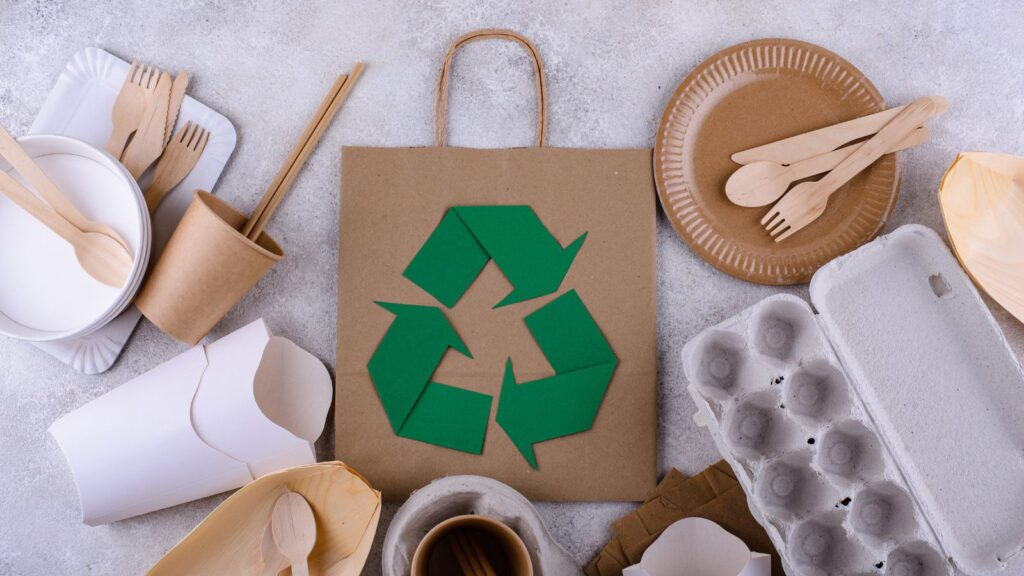Sustainable food packaging options are not only an ethical choice—they are also a strategic business decision. Consumers are increasingly demanding environmentally friendly products, and businesses must adapt to meet these expectations. Sustainable packaging reduces environmental impact, enhances brand image, and can even lead to cost savings in the long run.
Here are several sustainable food packaging options that can help your business align with these values.
Table of Contents
Biodegradable and Compostable Packaging
Biodegradable and compostable packaging materials break down naturally in the environment, therefore reducing landfill waste. These materials are often made from plant-based resources such as corn starch, sugarcane, or bamboo. For instance, PLA (polylactic acid) is a popular biodegradable plastic alternative derived from renewable resources like corn.
Similarly, packaging made from bagasse (a byproduct of sugarcane processing) is both compostable and sturdy, making it ideal for food containers and plates. You could also invest in thermal insulated envelopes from Woolcool, as these contain wool, which is biodegrade at the end of its useful life.
Recyclable Materials
Recycling is a cornerstone of sustainable packaging. Using materials that can be easily recycled reduces the need for virgin resources and lowers environmental impact. Common recyclable packaging materials include glass, aluminum, and certain plastics like PET (polyethylene terephthalate). Businesses can encourage recycling by clearly labeling packaging with recycling information and providing incentives for customers to return used packaging.
Reusable Packaging
Reusable packaging is a sensible alternative to single-use options. Items like glass jars, metal tins, and durable plastic containers can be reused repeatedly, reducing waste and promoting a circular economy. Implementing a return-and-refill program, where customers return used packaging for a discount on their next purchase, can encourage reuse and build customer loyalty.
Edible Packaging
Edible packaging is an innovative solution that eliminates waste entirely. Made from natural, food-grade ingredients, this packaging can be consumed along with the product. Examples include rice paper wrappers, seaweed-based materials, and edible coatings made from proteins and polysaccharides. While still emerging, edible packaging represents a promising area for future sustainable packaging solutions.
Minimalist Packaging
Reducing the amount of packaging material used is another effective strategy. Minimalist packaging focuses on using just enough material to protect the product, avoiding excess. This approach not only reduces the amount of waste but can also lower costs. Techniques include using thinner materials, designing compact packaging shapes, and eliminating unnecessary layers.
Eco-Friendly Inks and Labels
Traditional inks and labels often contain harmful chemicals and are difficult to recycle. Switching to eco-friendly inks made from soy or vegetable bases can reduce the environmental impact. Similarly, using labels made from biodegradable or recyclable materials ensures the entire package is sustainable. Ensuring that labels are easily removable can also facilitate recycling.
Sustainable Paper and Cardboard
Paper and cardboard are widely used in food packaging and can be sustainable if sourced responsibly. Look for packaging certified by organizations like the Forest Stewardship Council (FSC), which ensures that the materials come from responsibly managed forests. Recycled paper and cardboard are also good options, as this reduces the need for virgin materials and supports the recycling industry.
Mushroom Packaging
Mushroom packaging—made from agricultural waste and mycelium (the root structure of mushrooms)—is a biodegradable and compostable option that is gaining popularity. This packaging is grown, not manufactured, and decomposes completely within weeks when discarded. It is a versatile material that can be molded into various shapes, making it suitable for a range of food products.
Plant-Based Plastics
As mentioned above, plant-based plastics, or bioplastics, are made from renewable resources like corn, sugarcane, or potatoes. These plastics can be designed to be biodegradable or recyclable, offering a more sustainable alternative to traditional petroleum-based plastics. For example, PHA (polyhydroxyalkanoates) is a type of bioplastic that is fully biodegradable and compostable, suitable for various packaging applications.
Conclusion
Adopting sustainable food packaging is essential for businesses aiming to reduce their environmental footprint and meet consumer demand for eco-friendly products, and the types of packing highlighted above offer diverse ways to achieve this goal. By integrating sustainable practices, businesses can not only contribute to a healthier planet but also enhance their brand reputation and foster customer loyalty.
As technology and innovation continue to advance, the range of sustainable packaging options will only expand, providing even more opportunities for businesses to make a positive impact.



